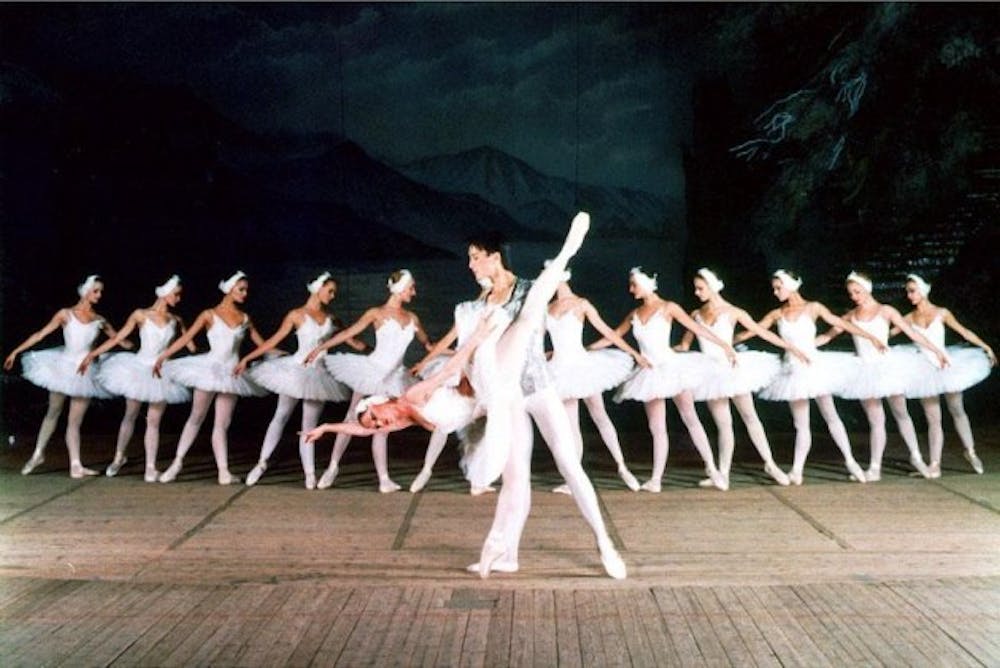Light as a feather and strong as sinew, they cast a spell.
On Tuesday night, the Russian National Ballet Theatre performed Peter Ilyich Tchaikovsky's legendary Swan Lake ballet at UB's Center For the Arts.
The story revolved around Prince Siegfried as he comes of age and finds his true love in an unexpected place - Swan Lake. Siegfried is pressured by the demands of royalty which require him to find a wife and fulfill a sense of duty, but in discovering the Swan Queen Odette, he abandons his life for love.
Odette is a princess who takes the form of a swan by day under the curse of the evil sorcerer Von Rothbart. Siegfried is captivated as he witnesses Odette's transformation into human form by night, and he instantly falls in love. The spell can only be broken by true love, but before Siegfried can save Odette, Von Rothbart deceives him.
Von Rothbart forces Odile, the black swan who appears as Odette's twin, to seduce Siegfried. When Siegfried mistakenly falls for Odile, Von Rothbart's curse is permanently fixed on Odette and the other swans. Only by killing themselves do Siegfried and Odette break Von Rothbart's curse and ascend to Heaven together.
Traditionally, the roles of Odette and Odile are played by the same dancer, and for this show, Maria Sokolnikova gave a breathtaking performance as both the white and black swan.
Aidos Zakan performed the role of Prince Siegfried and proved his worthiness for the male lead with a jaw dropping display of grace and athleticism. Only the Jester matched Zakan's ability with solo routines that drew wild applause and animated reactions from the audience throughout the show.
The male dancers' muscles bulged through tight leggings, threatening to tear them with each leap and spin, yet the flexibility and artistic finesse displayed in their movements on stage were most impressive - ballet dancers double as highly conditioned athletes and artists at the same time.
The female dancers carried a different kind of beauty. Their strength was hidden underneath seemingly frail skeletons of bone and slimmed and trimmed muscle. At times the swans appeared so fragile that the anticipation of a snapped ankle or fainting on stage seemed inevitable with the physical exertion that the routines demanded.
However, the entire cast of swans executed with an enduring strength that left the audience standing for an ovation at the end of the show.
Donald Martin of Niagara Falls is an usher for 12 theatres across the Buffalo area, including the Center For the Arts. At 77, he has seen some memorable performances throughout the years.
"Tonight gave me goosebumps," Martin said. "Of all the forms of art I like dance the best, and of all the forms of dance I think ballet is the most beautiful. It's artistic. It gives me chills to be a part of it."
Under the direction of Elena Radchenko, a legendary Bolshoi dancer, the entire Corps de Ballet seemed flawless.
Swan Lake set the scene for most of the story. A stunning glow of misty blue light bathed the dancers in both fully lit daytime scenes and in the moonlight of some of the more intimate nighttime moments, particularly with the swans.
The set was minimalistic, with drapes and painted backdrops used for depicting scenes within the castle or outdoors in wooded areas. Other effects, aside from a laughably pathetic fog machine, were non-existent.
It didn't matter.
The dancers did all the work by putting the "motion" in emotion. And with no words to tell the story, their bodies did the talking.
In contemporary culture, there seems to be an expectation, especially from younger audiences, for big effects and digital "wow" factors that provide quick, fast and easy edge-of-seat entertainment. Swan Lake serves as a reminder of how the human body itself can deliver all the necessary "flashes" and "bangs" that audiences get from the big screen along with the subtleties that move an audience in ways that technology cannot.
Digital mediums lack this certain kind of magic.
Many are familiar with Swan Lake through its depiction in the 2010 Academy Award winning film Black Swan.
Mary Pappagallo, 16, of Amherst is a 12-year student of ballet who attends the Lisa Taylor Academy of Ballet and Dance Arts in Buffalo. She swears she has not seen the film, and Tuesday night was her first time experiencing the "real" Swan Lake.
"I really enjoyed it," Pappagallo said. "We've done variations in class, which was fun. Being able to see professionals perform them on stage was a great experience."
Swan Lakeslowly churned its legs, and by the end, it was hard to not be fully engulfed in the action with the acute attention to every detail and overwhelming emotional involvement in Siegfried and Odette's story.
Much can be said about the dancing as the music that accompanies the ballet - one is simply not as satisfying without the other. Certainly one of Tchaikovsky's master works, the music for Swan Lake is mesmerizing. Outside the Center For the Arts, the show went on as ecstatic audience members whistled or hummed the memorable bits of the music on their way out the door.
Director of International Student and Scholar Services at UB, Ellen Dussourd, attended with her 96-year-old mother, Eugenia, and she remembers seeing the Bolshoi Ballet perform Swan Lake live in Kiev, complete with a full orchestra.
"I thought [tonight] was beautiful," Dussourd said. "Exquisite."
While a live performance of the music by a full orchestra may have been more impressive, this particular performance allowed for a focus on the action. The Mainstage Theatre at the Center For the Arts was intimate enough for a closeness that made the live performance feel personal and big enough to draw a large crowd that roared out into the night with cheers of bravo.





